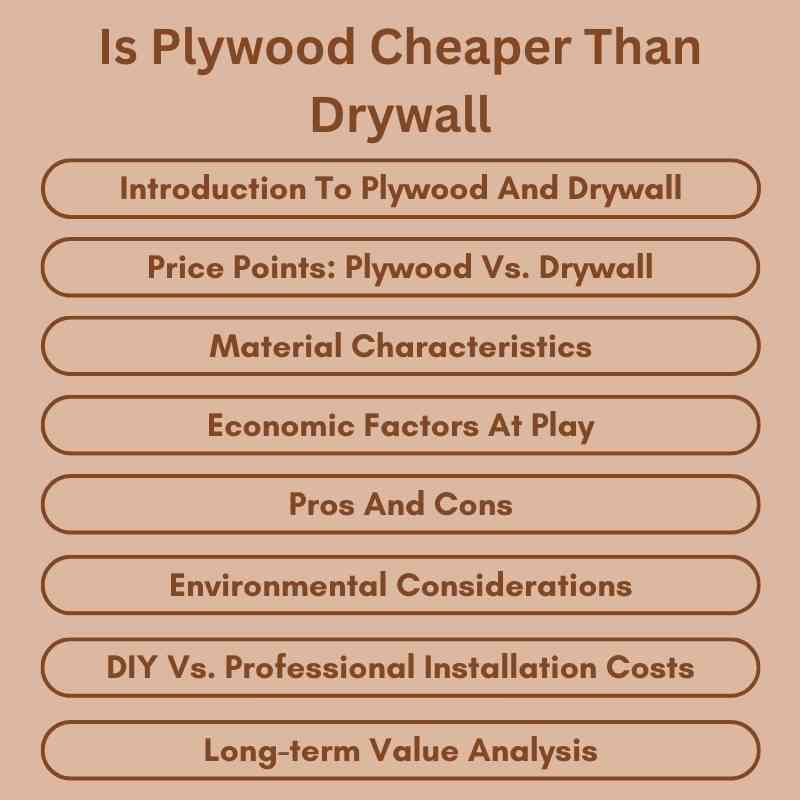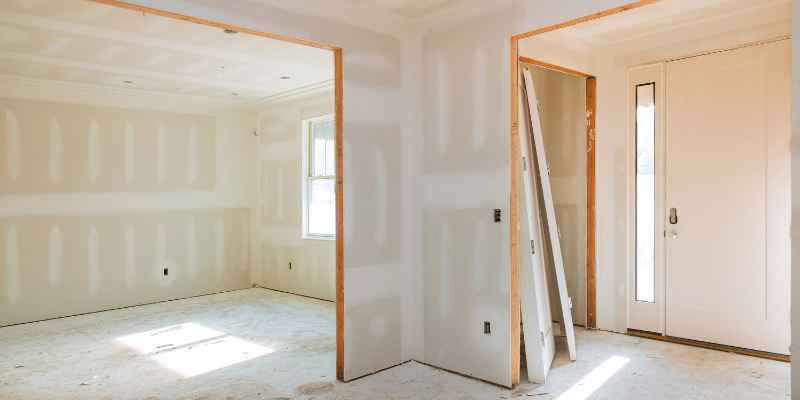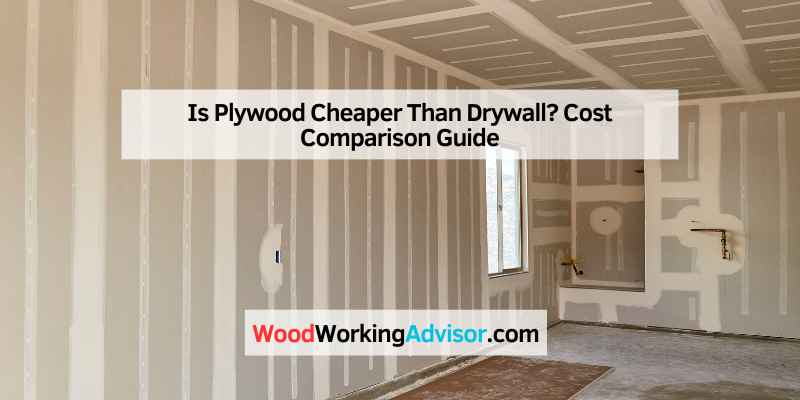Plywood is generally more expensive than drywall. Prices can vary based on quality, thickness, and local market conditions.
Plywood and drywall serve different purposes in construction. Plywood is a durable material often used for flooring, walls, and furniture. It provides structural support and is known for its strength. In contrast, drywall is primarily used for interior walls and ceilings.
It offers a smooth finish and is easier to install. Understanding the differences in cost and application is crucial for homeowners and builders. Budget considerations can influence your choice between these materials. Knowing the pros and cons of plywood and drywall will help you make informed decisions for your projects. This guide will clarify their costs and uses to assist in your planning.
Introduction To Plywood And Drywall
Plywood and drywall are common materials in construction. Each serves a unique purpose.
Plywood is made from thin layers of wood. It is strong and versatile. Common uses include flooring, furniture, and cabinetry.
Drywall is made from gypsum. It is used mainly for walls and ceilings. It helps with insulation and fire resistance.
| Material | Common Uses |
|---|---|
| Plywood | Flooring, Furniture, Cabinets |
| Drywall | Walls, Ceilings, Insulation |

Price Points: Plywood Vs. Drywall
The average cost of plywood ranges from $15 to $50 per sheet. Drywall typically costs $10 to $20 per sheet. Plywood is often more expensive than drywall. However, prices can vary based on quality and type.
Several factors influence the prices of these materials. Material quality plays a significant role. Higher-quality plywood can cost much more. The size of the project also affects total costs. Larger projects may have different pricing structures.
Location impacts prices as well. Local demand and supply can change costs significantly. Lastly, installation costs vary between plywood and drywall. Plywood often requires more skilled labor to install.
Material Characteristics
Plywood is known for its high durability and long lifespan. It can withstand moisture and heavy loads better than drywall. Plywood tends to resist warping and cracking over time.
Drywall is less durable. It may damage easily from impacts or moisture. Its lifespan is shorter, especially in wet areas.
Installation of plywood can be more complex. It often requires special tools and skills. Labor costs might be higher compared to drywall.
Drywall is quicker to install. Most people can do it with basic tools. Labor costs are usually lower than plywood installation.
Economic Factors At Play
Plywood and drywall prices depend on many factors. Market trends can change quickly. Prices may rise or fall based on demand. Economic conditions also play a big role.
Availability of materials impacts costs. If supplies are low, prices increase. Supply chain issues can create delays. These delays lead to higher prices for both materials.
| Factor | Plywood | Drywall |
|---|---|---|
| Market Trends | Subject to rapid changes | More stable pricing |
| Availability | Can be limited | Usually widely available |
| Supply Chain | Affected by shortages | Less affected |
Pros And Cons
Plywood offers several advantages. It is stronger and more durable than drywall. This material can resist moisture better. It is also lightweight and easy to work with.
Plywood can be used for various projects, including furniture and cabinetry. Its natural beauty adds charm to homes. Plywood is often more cost-effective for larger areas.
Drywall has its own benefits. It is fire-resistant and provides better soundproofing. Installation is usually quicker and easier. Drywall can create a smooth, finished look for walls.
Both materials have their place in construction. Choosing the right one depends on specific needs.
Environmental Considerations
Sustainability plays a big role in comparing plywood and drywall. Plywood is often made from renewable resources. Trees can be replanted, making it a more sustainable choice.
Drywall, on the other hand, has a larger carbon footprint. It uses minerals and chemicals that may harm the environment.
Both materials can be recycled, but their processes differ. Plywood can be reused in many projects. It reduces waste significantly.
Drywall recycling is less common and often leads to landfill waste. Choosing plywood can help promote a more eco-friendly building option.
DIY Vs. Professional Installation Costs
DIY projects can save money. Plywood is often cheaper than drywall. Many people choose plywood for walls and ceilings. It can also provide better strength.
Costs for hiring contractors vary. Professionals may charge more for drywall installation. Plywood installation can be faster and simpler. This may lower labor costs.
| Material | DIY Cost | Contractor Cost |
|---|---|---|
| Plywood | Low | Moderate |
| Drywall | Moderate | High |
Choosing materials wisely helps save money. Always compare prices before starting a project.
Long-term Value Analysis
Plywood often requires less maintenance compared to drywall. It can withstand moisture and damage better. This durability can lead to lower long-term costs for repairs.
Drywall may need frequent repairs, especially in high-traffic areas. Plywood’s strength means fewer replacement needs over time. This makes plywood a cost-effective choice in the long run.
Resale value can differ based on material choices. Homes with plywood may appeal to certain buyers. Plywood can add a unique aesthetic, increasing overall value.
Drywall is common in most homes. While cheap initially, it may not hold its value as well. Plywood’s distinctive look can attract buyers willing to pay more.

Frequently Asked Questions
Is Plywood More Affordable Than Drywall?
Plywood can often be cheaper than drywall, depending on the size and thickness. It provides better structural support, making it a cost-effective choice for certain projects. However, drywall is generally less expensive for wall finishes. Prices can vary based on local availability and specific project needs.
What Are The Benefits Of Plywood Over Drywall?
Plywood offers superior durability and resistance to moisture, making it ideal for high-humidity areas. It’s also easier to repair and can support heavy fixtures. Additionally, plywood can be more versatile for various applications, including flooring and cabinetry, giving it an edge in some situations.
When Should I Choose Drywall Instead Of Plywood?
Choose drywall for standard wall applications where smooth finishes are required. It’s lighter and easier to install, making it a favorite for interior walls. Drywall also provides better sound insulation and fire resistance compared to plywood, which can be essential in residential settings.
How Do Installation Costs Compare Between Plywood And Drywall?
Installation costs vary based on the complexity of the project. Drywall installation is typically faster and requires less labor, which can lower overall costs. Plywood may need additional framing and finishing work, potentially increasing labor costs. Always consider the total project budget when making your choice.
Conclusion
Plywood and drywall each have their own cost benefits. Plywood typically offers durability and versatility, while drywall is often cheaper for wall finishing. Ultimately, the best choice depends on your specific project needs and budget. Assessing these factors will help you make an informed decision that suits your requirements.

